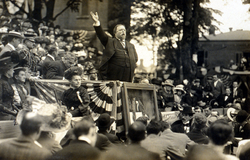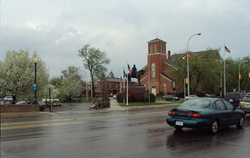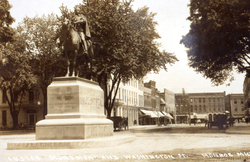- George Armstrong Custer Equestrian Monument
-
George Armstrong Custer
Equestrian Monument Location within the state of Michigan
Location within the state of MichiganLocation: Junction of Elm Avenue and North Monroe Street
Monroe, MichiganCoordinates: 41°55′05″N 83°23′48″W / 41.91806°N 83.39667°WCoordinates: 41°55′05″N 83°23′48″W / 41.91806°N 83.39667°W Built: 1910 Architect: Hunt & Hunt[2] Sculptor: Edward Clark Potter Governing body: Local NRHP Reference#: 94001430[1] Significant dates Added to NRHP: December 9, 1994 Designated MSHS: June 15, 1992[3] The George Armstrong Custer Equestrian Monument, also known as Sighting the Enemy[4][5], is an equestrian statue of George Armstrong Custer by Edward Clark Potter, located in Monroe, Michigan. The statue was unveiled on June 4, 1910. It was designated a Michigan Historic Site on June 15, 1992[3] and was listed on the National Register of Historic Places on December 9, 1994.[1]
While Custer was not born in Monroe, he lived much of his early childhood living with relatives and going to school in Monroe. During his youth, he met his future wife Elizabeth Bacon, whom he returned to marry in 1864. Custer eventually left Monroe to attend the United States Military Academy and fight in the Civil War. Because of his hard work and success during the war — as well as the Union's need for officers — he was promoted to the rank of Major General and was a very well known military figure. After the Civil War, he partook in the Indian Wars. His previous accomplishments in the Civil War, however, were overshadowed by his catastrophic defeat and death at the Battle of the Little Big Horn on June 25, 1876.[6]
To honor him, a $24,000, 14-foot (4.27 m) bronze equestrian statue, sculpted by Edward Clark Potter, was unveiled in Monroe in 1910 by then-President William Howard Taft and Elizabeth Bacon Custer.[2] The statue commemorates his successful actions during the Civil War and not his more well known failure during the later Indian Wars.[7]
Location
 President Taft speaks to a gathering crowd at the unveiling of the statue in 1910. Elizabeth Bacon Custer is pictured just below Taft.
President Taft speaks to a gathering crowd at the unveiling of the statue in 1910. Elizabeth Bacon Custer is pictured just below Taft.
Throughout the statue's century long lifespan, it has been placed in three different locations. The statue was originally located in the middle of the brick-laden intersection of First Street and Washington Street in front of the courthouse in the present day Old Village Historic Village.[6] His widow Elizabeth Custer, who spent much of her later life improving Custer's reputation and public image, argued that the statue was in a less-deserving location in Monroe. Others complained that the statue was a traffic hazard since it was located in the middle of an intersection. When it was first erected, traffic was sparse in Monroe, but automobile traffic was drastically increasing. On June 20, 1923, the statue was moved to a new location in Soldiers and Sailors Park along the River Raisin.[8] There, the statue remained in relative isolation and was eventually obscured by unkempt scrubs and trees.
Because of public protests, the city moved the statue to a better location in August 1955. When movers arrived to take the statue to a new location, they originally could not find it within the overgrown vegetation.[7] The statue was moved to its current location on the southwest corner of Elm Avenue and North Monroe Street along the River Raisin.[8] Its current location is at one of the most prominent intersections in the city, and the statue is well lit at night. The statue is now one of the most recognizable objects in Monroe.[7] The George Armstrong Custer Equestrian Monument is located across Elm Street from the St. Mary's Church Complex Historic District and adjacent to the East Elm-North Macomb Street Historic District. It is also located just north of the River Raisin from the Old Village Historic District, where it was originally located.
Monument
 The statue in its current location at the corner of Elm Street and North Monroe Street
The statue in its current location at the corner of Elm Street and North Monroe Street
Today, there is some controversy surrounding this statue, as Custer himself had no involvement or influence in Monroe other than the fact that he lived a few years of his youth there. Moreover, his current reputation is somewhat tarnished by his violent actions against Native Americans during a time of great conflict and American expansionism in the West. Proponents of the statue argue that it represents Custer's spectacular service to the Union during the Civil War and not his failed efforts at the Battle of the Little Big Horn.[8] The statue shows Custer wearing his Civil War fatigues, and since he did not die during the Civil War, the horse in the sculpture traditionally has all four legs on the ground, even though Custer did die in a battle years after the end of the Civil War.[7] The historical marker commemorating the statue reads:
- Major-General George Armstrong Custer. Born in New Rumley, Ohio, George A. Custer grew up in Monroe in the home of his half-sister, Mrs. David Reed. February 9, 1864, in the Presbyterian Church here, he married Libbie Bacon, only daughter of Judge Daniel S. Bacon. During the Civil War, he received six brevets and was made Major-General before he was 26 years old, a rare distinction. From 1866 until his death at the Battle of the Little Big Horn, General Custer commanded the famous Seventh Cavalry Regiment, leading them in scouting and Indian fighting throughout Kansas and the Dakota Territory. This statue of General Custer, created by Edward C. Potter, was erected by the State of Michigan, unveiled by Mrs. Elizabeth B. Custer and dedicated by President William Howard Taft, June 4, 1910. The statue was rededicated September 3 1955, by the First Cavalry Division of which Custer's Seventh Cavalry Regiment was a part.[2][9]
References
- ^ a b "National Register Information System". National Register of Historic Places. National Park Service. 2009-03-13. http://nrhp.focus.nps.gov/.
- ^ a b c May, George F. (1965). "Michigan Civil War Monuments". http://www.suvcwmi.org/memorials/mcwm3.html. Retrieved November 15, 2009.
- ^ a b State of Michigan (2009). "Custer, George Armstrong, Equestrian Monument". http://www.mcgi.state.mi.us/hso/sites/17698.htm. Retrieved June 26, 2010.
- ^ Monroe Evening News staff (05 July 2008). "Alexander marks Gettysburg anniversary". Monroe Evening News (Monroe, Michigan). http://www.monroenews.com/apps/pbcs.dll/article?AID=/20080705/NEWS01/821392122/-1/NEWS. Retrieved November 15, 2009.
- ^ Monroe County Library System (2009). "George Armstrong Custer Chronology". http://monroe.lib.mi.us/books_movies_music/special_collections/custer_news_chronology.htm. Retrieved November 14, 2009.
- ^ a b New York Times (15 May 1910). "President Will Help Dedicate the Custer Monument" (PDF). New York Times. http://query.nytimes.com/mem/archive-free/pdf?_r=2&res=9D0DE7DA1530E233A25756C1A9639C946196D6CF. Retrieved April 3, 2009.
- ^ a b c d Monroe County Library System (2009). "The George Armstrong Custer Collection of the Monroe County Library System". http://monroe.lib.mi.us/books_movies_music/special_collections/custer_related_sites.htm. Retrieved November 14, 2009.
- ^ a b c Monroe County Library System (2009). "Custer Statue Had Three Sites During Tenure in City". http://monroe.lib.mi.us/books_movies_music/special_collections/custer_statue_home.htm. Retrieved November 14, 2009.
- ^ Monroe County Convention and Tourism Bureau (2005–2009). "Monroe County Historic Sites" (Page 5). http://www.monroeinfo.com/history-historicsites.asp. Retrieved December 27, 2010.
National Register of Historic Places in Monroe County, Michigan Historic districts Dundee Historic District | East Elm-North Macomb Street Historic District | North Maumee Bay Archeological District | Old Village Historic District | St. Mary's Church Complex Historic District

Historic properties Detroit River Light Station | Edward Loranger House | George Armstrong Custer Equestrian Monument | Governor Robert McClelland House | Jefferson Avenue-Huron River Bridge | Navarre-Anderson Trading Post | River Raisin National Battlefield Park | Rudolph Nims House | Sawyer House | Weis Manufacturing Company
Contributing properties Old Mill Museum | St. Mary Catholic Central High School
U.S. National Register of Historic Places Topics Lists by states Alabama • Alaska • Arizona • Arkansas • California • Colorado • Connecticut • Delaware • Florida • Georgia • Hawaii • Idaho • Illinois • Indiana • Iowa • Kansas • Kentucky • Louisiana • Maine • Maryland • Massachusetts • Michigan • Minnesota • Mississippi • Missouri • Montana • Nebraska • Nevada • New Hampshire • New Jersey • New Mexico • New York • North Carolina • North Dakota • Ohio • Oklahoma • Oregon • Pennsylvania • Rhode Island • South Carolina • South Dakota • Tennessee • Texas • Utah • Vermont • Virginia • Washington • West Virginia • Wisconsin • WyomingLists by territories Lists by associated states Other Categories:- Monroe, Michigan
- Monuments and memorials in Michigan
- National Register of Historic Places in Michigan
- Michigan State Historic Sites
- Michigan in the American Civil War
- Buildings and structures in Monroe County, Michigan
- Outdoor sculptures in Michigan
- Equestrian statues
Wikimedia Foundation. 2010.


